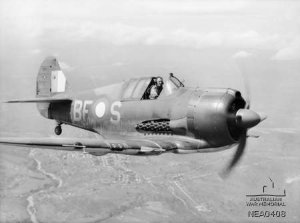![]() The Pacific War Online Encyclopedia
The Pacific War Online Encyclopedia
|
| Previous: Bonneville | Table of Contents | Next: Bora Bora |

Australian War Memorial #NEA0408
CA-12 Boomerang
| Crew | 1 |
| Dimensions | 36'0" x 25'6" x
10'6" 10.97m by 7.77m by 3.20m |
| Wing Area | 225 square feet 20.9 square meters |
| Weights | 5373-8249 lbs 2437-3492 kg |
| Maximum speed | 305 mph at 15,500 feet 491 km/h at 4725 m |
| Cruise speed | 190
mph 305 km/h |
| Rate of climb | 49 feet per second 14.9 m/s |
| Ceiling | 34,000 feet 10,000 m |
| Powerplant | One 1200 hp (895 kW) Pratt & Whitney R-1830-S3C4G Twin Wasp 14-cylinder two-row radial engine driving a three-bladed propeller. |
| Armament | 2 20mm Hispano Mk.II cannon and 4 0.303 machine guns in the wings |
| External stores | 4 20lb (9 kg) smoke bombs Drop tank |
| Fuel | 192 gallons 727 liters |
| Range | 930 miles 1500 km |
| Production | 249 of all models from August 1942 to late 1944 at Commonwealth Aircraft Corporation, Fishermen's Bend, Melbourne. |
During the dark days of early 1942, Commonwealth Aircraft Corporation decided to begin producing desperately needed fighter aircraft for the Royal Australian Air Force. To speed design, the basic airframe was based on the North American T-6 Texan trainer adapted to take the only engine available, the Twin Wasp, which was produced locally under license. Surprisingly, the resulting aircraft, though underpowered, was rugged and maneuverable. However, by the time it went into service, P-40s and Spitfires were arriving in quantity and the need for the Boomerang had passed. it was much more successful in the target spotting and close support roles than as a fighter.
References
The Pacific War Online Encyclopedia © 2007, 2009, 2011 by Kent G. Budge. Index